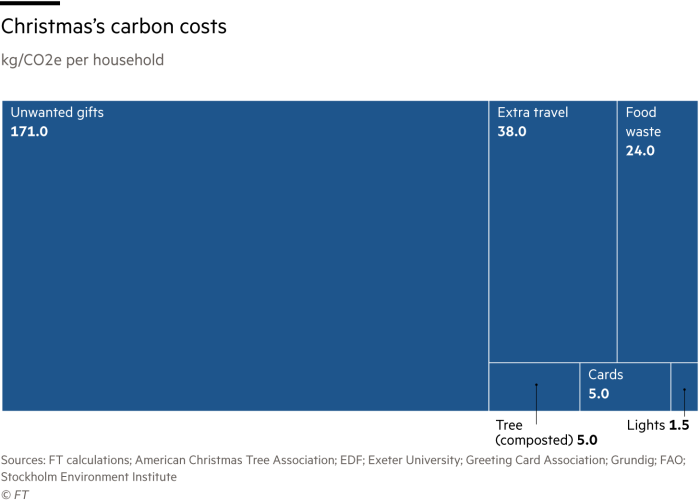Carbon counter: celebrate sustainably with well-chosen gifts

Roula Khalaf, Editor of the FT, selects her favourite stories in this weekly newsletter.
Dreaming of a green Christmas? Lex tapped its inner Grinch to calculate the carbon cost of a household’s celebrations, basing its figures on UK average spending patterns. Badly-chosen presents accounted for as much as two-thirds of the festive season’s footprint.
This idea derives from “Scroogenomics”, the brainchild of economist Joel Waldfogel who calculated that between 10 per cent and a third of gifts, by value, were wasted. Some economists, trying to redeem the dismal science’s reputation, argue that the pleasure from giving the gift can make all the difference.
Regardless, a lot will end up gathering dust or in landfill. The carbon cost of wasted gifts, many ordered online this year, comes to 171kg of carbon dioxide equivalent (CO2e) per household, based on figures compiled by the Stockholm Environment Institute.

Travel can also ratchet up emissions. The average Briton drives about 100 miles to visit friends and family over the holidays. Lex allowed about 40kg of CO2e, assuming the household travelled in one vehicle. But the total could be anything from 5kg to over 100kg depending on the type of vehicle, speed and traffic conditions.
Instead of totting up the carbon impact of all festive food, Lex focused on waste. The carbon cost of 1kg of uneaten goodies is 2.5kg of CO2e, based on a global average. Assuming 270,000 tonnes of food is wasted UK-wide over the holiday — 6 per cent of the annual total — the CO2e emitted per household is 24kg.
A Christmas tree emits just under 5kg of CO2e over its lifetime if it is composted, more if it is incinerated. That calculation, from the American Christmas Tree Association, depends on how much of the tree’s sequestered carbon is released. If the old tree ends up in landfill — and the methane released is used for electricity — it can help curb emissions.
Christmas cards have a similar carbon footprint to a composted tree, given that an average household mails 35 of them. Christmas lights are modest contributors, assuming low energy bulbs.
Laying on a lavish Christmas can be carbon-costly. Emissions can be as high as 1,500kg per adult, according to carbon researcher Mike Berners-Lee. A more modest celebration would emit 250kg of CO2e, just 1 per cent of a household’s annual total. As Stevie Wonder remarked, the season can bring joy without too many toys.
Carbon counter is a series of Lex articles explaining how readers can reduce their CO2 footprints via judicious lifestyle changes. Read other articles on the calculations behind greener choices here.
Climate Capital

Where climate change meets business, markets and politics. Explore the FT’s coverage here.
Are you curious about the FT’s environmental sustainability commitments? Find out more about our science-based targets here

Comments